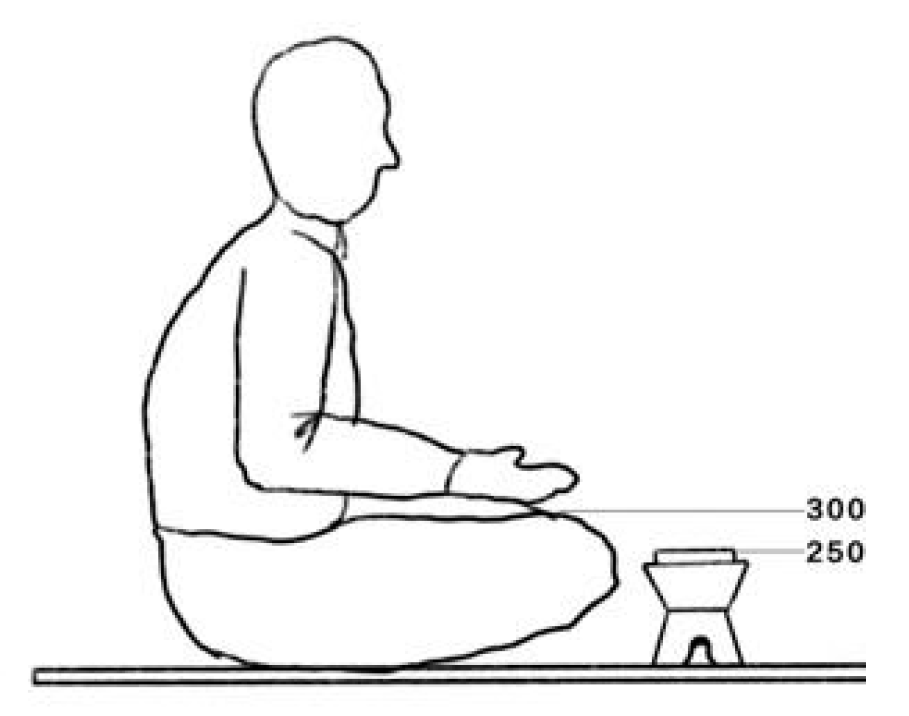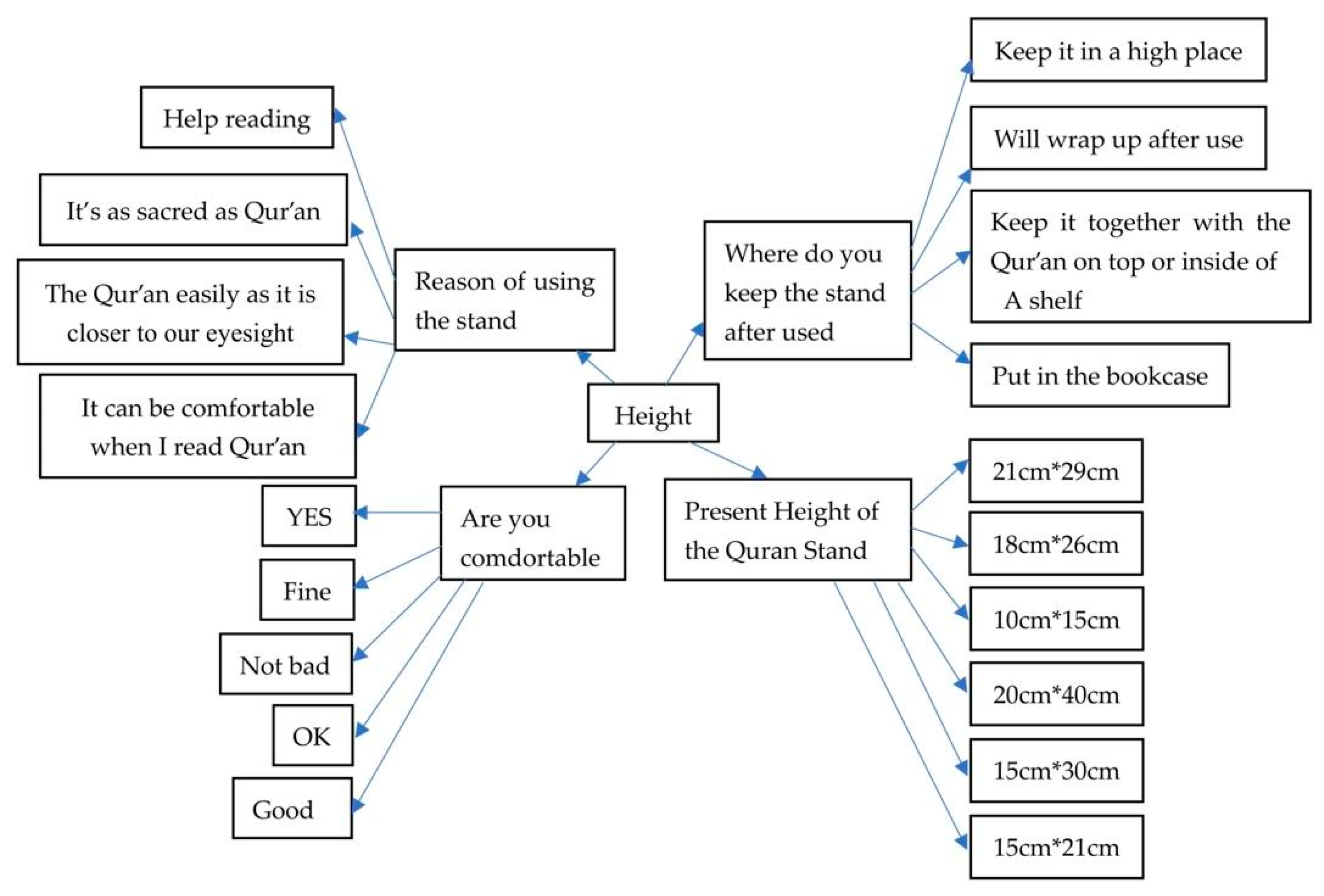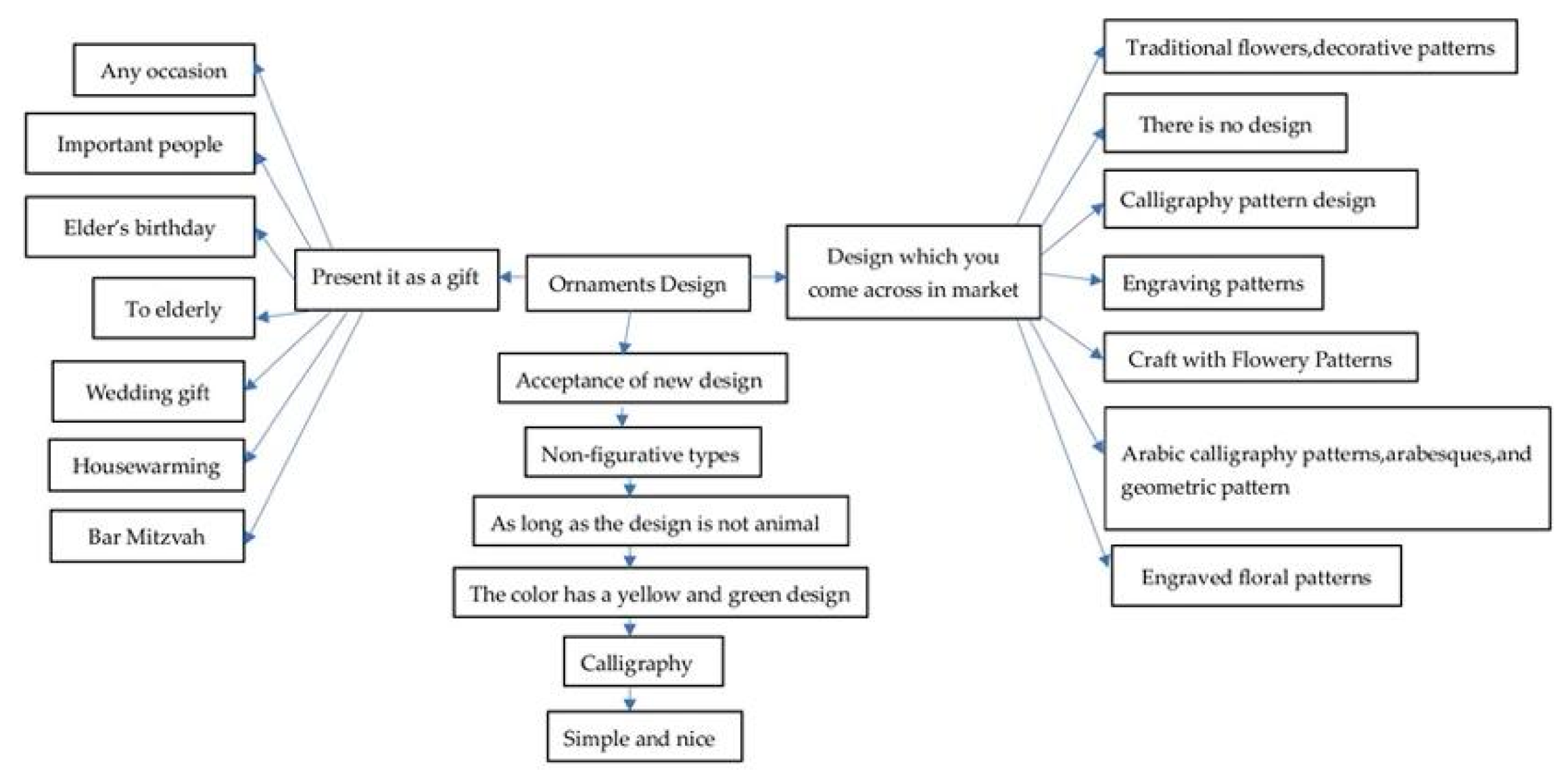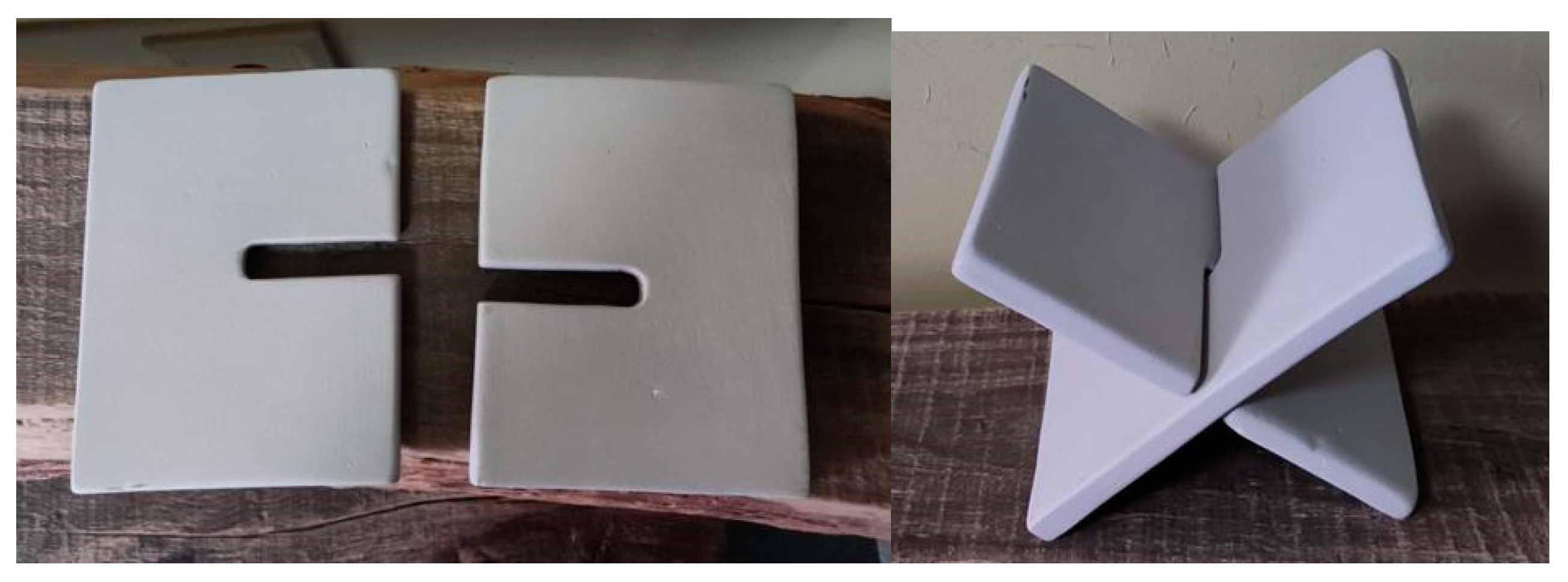1. Introduction
The rehal is a holy book holder. It is essentially a small stand used by Muslims, Hindus, Sikhs, and Christians to hold and ensure respect for religious texts during recitation. In Malaysia, rehals are normally used by the Muslim majority, who place their Quran on top while they recite the surahs. Traditionally, rehals are made from wood, and assembled by interlocking two similarly sized pieces of wood. This means the rehal can be easily dismantled for storage when not in use [
1]. The surface of the rehal is usually decorated with Islamic calligraphy, abstract flowers, or Arabic motifs [
2]. Rehals are used by Muslim people worldwide, regardless of race, age, status, or social class [
3].
Most of the rehals found on the market nowadays are made out of wood or plastic. However, these materials present different sustainability issues. Under moist conditions, wooden rehals provide a breeding ground for pathogenic microorganisms, which pose a threat to human health. Meanwhile, the plastics used for rehals are derived from non-renewable fossil fuels, which will eventually be depleted and are therefore not sustainable. This study explores the Malaysian Muslim perspective on prospective new rehal designs that use eco-friendly sustainable alternative materials because the Quran says that human beings should have self-discipline and respect all life with kindness, and protect and maintain the balance of the natural ecosystem [
4]. Ahmad et al. suggested adjusting the height of commercial rehals, which ranges from 20 to 25 cm [
5], to achieve optimum reading height [
6] because ease of reading allows users to focus on their studies. Thus, a good rehal design is crucial. Since traditional rehal ornamentation and decorations have remained largely the same throughout the years, this study also investigates the possibility of creating rehals with more modern decorations, patterns, or ornamentation.
The objectives of this study are to (1) create an environmentally friendly rehal by using sustainable material, (2) optimize the height of rehal based on human ergonomics, and (3) design modern rehal embellishments that are acceptable in the eyes of Islam. The data collected from this study will serve as a design guideline that enables the creation of a well-received Malaysian rehal.
The research scope includes the standard rehal as the research object and aims to design an environmentally friendly and sanitary rehal by improving the material, height, and decorations based on the theory and data collected from the pilot test. From the literature review, the researcher learned that modern rehals may come with extra features, such as a box or modifications that allow it to be transformed into a bag [
1]. To streamline the initial research, only traditional designs were examined in this study. However, new rehal ideas should be explored via innovation and design in the future.
2. Literature Review
Learning the Quran is an important act in Islam. The Quran is a sacred text that requires a proper holder, which in this case is called rehal. Rehal’s craftsmanship is mainly manifested in shape, form, and decoration, which indirectly reflects the artistic identity of the culture. Rehal is one of the treasures of Islamic art; its historical origin and art culture have spread to China, Indonesia, Turkey, India, Japan, Nepal, Africa, and all over the world [
3].
2.1. The Types of Rehals
The rehal is an X-shaped book stand that can be collapsed into a flat form (
Figure 1). It is used to hold sacred texts during recitation by keeping them elevated off the floor. There are various types of rehals in the market today, which are mainly made of wood, plastic, and metal.
There are two rehals on display in the Islamic Arts Museum of Malaysia in Kuala Lumpur. The one from India has inlaid brass and exquisitely crafted floral motifs on its surface (
Figure 2a). The second, which is from Egypt, is decorated with carvings, inlaid with bones, pearls, shells, and aggregates (
Figure 2b). The rehal in (
Figure 2c), is a Mongolian Empire Quran shelf displayed in the National Palace Museum, Taipei, Taiwan [
7]. This rehal is made of jade and covered with flower and leaf patterns. The edge is decorated with a column of crown lace, which is full of Islamic style and imbued with cultural value.
2.2. Dimensions and Height of Rehal
According to the architect’s handbook of ergonomic guidelines, the average adult male sitting in a cross-legged position will place their hands at about 300 mm off the ground [
8]. However, commercial rehals have a height that ranges from 200 to 250 mm (
Figure 3). Hence, the height of the existing rehal can be further optimised (Ahmad et al., 2021).
2.3. Islamic Wooden Rehal
Rehals are a sacred tool that Muslims use during Quran recitations. It preserves the sanctity of the Quran by keeping it off the floor while placing it within an accessible distance and angle. However, the usage of wooden rehal raises a few issues. First of all, wooden rehals require the cutting down of trees, which is not ideal. Secondly, wooden rehals are prone to discolouration with the passing of time. They may fade or darken, losing their original lustre. In addition, improperly prepared wood may crack due to moisture, leading to the growth of microorganisms that can cause health issues. The combination of these issues require a wooden rehal to be replaced eventually. As the Quran has stated: “
I created all things by measure” (54:49), wasting resources is strictly forbidden. The Sharia stipulates that even if one does their cleaning by the river, they should not use an excessive amount of water. Similarly, Islam advocates for environmental protection and the optimisation of the living environment. The Prophet Muhammad said: “
A Muslim planted a tree and let people and livestock enjoy it, that is his giving, a good deed.” Planting a tree is not only a social virtue but an act of closeness to the Lord [
9].
2.4. Material Requirements for Product Design
Proper research should be conducted before the creation of a new rehal. The requirements for the new product include: resources should not be wasted, and the material should be eco-friendly [
10]. Since the product’s function, size, shape, manufacturing process, and aesthetics all affect consumer acceptance and decisions, only a product that tackles all these aspects deserves mass production.
3. Research Methods
3.1. Content Analysis
Two research methods were used in this study: Content analysis and in-depth interviews. Content analysis methods are aimed at providing knowledge and understanding of the phenomenon via studies and textual data [
11,
12,
13]. The researcher applied a directed approach to content analysis commencing coding with predetermined codes analysed from literature reviews, and analysing in-depth interviews with Malaysian Muslims, thus obtaining a consensus regarding rehal requirements in terms of material, height, colour, design, and ornamentation.
3.2. In-Depth Interview
An in-depth interview is a research method that conducts intensive interviews with a small group of interviewees to explore and obtain their views and opinions on a particular topic. It provides detailed information and personal thoughts on the topic and issues discussed [
14]. The interview methods can be grouped into three types: unstructured interviews, semi-structured interviews, and structured interviews.
3.3. Sample Size
This study explored the Malaysian Muslim’s perspective on present rehal materials [
15], optimum rehal height for comfortable reading while in a cross-legged position, and saisfaction level regarding rehal aesthetics. Purposive sampling was used to select seven adult Malaysian Muslims respondents. The seven respondents include three students —one postgraduate student and two undergraduate students, two businessmen, one Arabic language teacher, and one administrative officer. Before conducting the interviews, a check was performed to ensure that each respondent either owned, or had close proximity to a family member who owned at least one rehal to qualify as a sample. These interviews, each 20-30 minutes long, were conducted in Kuala Lumpur, on a weekday in April 2022 for the first four respondents, and on a weekend in early May 2022 for the remaining three respondents (see
Table 1). The communications were audio recorded with no interference from the interviewees’ thoughts during the interview process.
The interview questions are as below:
The material of their present rehal and whether they are able to accept other eco-material.
The extension of the height of rehal.
The colour, design, and ornaments of their present Rehal and are they able to accept new design.
3.4. Analysis of Interview Content
ATLAS.ti is a qualitative research tool for deductive coding, analysing transcripts, and creating network diagrams [
16]. It is rigorous in the analysis of the data and can produce credible results [
17]. Primary data was collected via in-depth interviews and three network diagrams were created by sorting out the vocabulary of the seven respondents.
Q1: What is their current rehal made of and can they accept rehals made from alternative eco-friendly materials?
In terms of material, all the interviewees responded that they had either owned, or seen wood rehals. Although R1, R4, and R5 have come across plastic rehals (57%), their family members prefer wood rehals (100%). In terms of rehal care, only R6 uses a dry brush to clean and preserve their rehal. The rest of the respondents use a wet cloth to wipe it (86%). When asked about problems encountered during rehal care, R1 and R6 mentioned deformation (29%), R2 talked about discoloration, R3 and R4 shared about how the wood was splitting apart (29%), and R7 said that their rehal became mouldy (29%) (
Figure 4,
Table 2)
Q2: What is the optimum height of the rehal?
All the respondents replied saying that rehals should be well kept and cared for properly. R1, R2, R4, and R6 mentioned that rehals should be placed in high places (57%). In particular, R3 mentioned that rehals should be wrapped with clean material after usage. Meanwhile, R5 and R6 mentioned that the book holders should be placed on a bookshelf or inside a book cabinet. Regarding the height of rehal, all the respondents have rehals with different sizes and heights; R1 and R4 use 21 cm × 29 cm rehals, R2 uses a 18 cm × 26 cm rehal, R3 uses a 10 cm × 15 cm rehal, R5 uses a 20 cm × 40 cm rehal, R6 uses a 15 cm × 30 cm rehal, and R7 uses a 15 cm × 21 cm rehal. The interviewees revealed that they felt that using a rehal helped them to read. Specifically, R6 mentioned that using a rehal increased their comfort while reading (71%). Although all respondents expressed satisfaction with the height and size of their current rehals, they also thought that adjusting the height was preferred (100%) (
Figure 5,
Table 3).
Q3: What are the designs and ornaments that adorn their current rehal and are different designs acceptable?
When it came to rehal decorations and designs, respondents R1 and R5 stated that their rehals featured traditional floral patterns. Meanwhile, R3 and R6 had Arabic calligraphy patterns (29%) on their rehals. R6’s rehal also had arabesque and geometric designs. R4 and R7 mentioned that their rehals were engraved with patterns (29%). While all the respondents felt that rehals are suitable as gifts, the appropriate occasion differed. According to R1, rehals are a suitable all-occasion gift. Meanwhile, R2 considered it more appropriate for VIPs. Respondents R3 and R4 mentioned that it could be gifted to the elderly. On the other hand, R5 considered it a wedding gift and R6 considered it a good housewarming gift. Lastly, R7 expressed that it was a decent present for a coming-of-age ceremony (100%). Respondents were willing to consider purchasing rehal with new or different designs. R1 and R6 indicated that they would accept newer designs while R2 stressed that there should be no animal motifs used (29%). R3 suggested green and yellow colour schemes and R4 recommended Jawi calligraphy. In contrast, R5 and R7 preferred contemporary minimalistic designs (29%) (See
Figure 6,
Table 4).
4. Conclusions
The interviews suggest that almost every Muslim family has a rehal. Wood and plastic are the two common materials used to make the rehal, and the most common cleaning method is to wipe the item with a wet cloth. Wooden rehals in particular are prone to moldiness, deformation, or discolouration. The intricate wood carvings may also present a challenge during the cleaning process. Respondents believe the rehal to be sacred. As such, they prefer to keep their rehals in locations far off the ground when not in use. While the current height of commercial rehals are sufficient, comfort can be increased if the height is increased because it will provide an illuminance level suitable for human visual comfort while sitting in a cross-legged position on the floor. At present, commercial rehals are mainly decorated with floral motifs and patterns. However, new designs can be used if they follow Islamic laws such as using non-figurative designs, and adding calligraphy.
4.1. Proposed Ecological Material for Rehal
After proper consideration of available materials, the researcher would like to propose ceramic as a new alternative eco-friendly material for rehals. Ceramic does not retain moisture. Hence, it does not face the same problems as wood such as discolouration, deformation, and health issues. Moreover, it fits the current aesthetic trends in modern society. Thus, it is a sustainable choice for new product designs.
Ceramic rehals have the following three advantages:
- (1)
It is made from clay—a material that can significantly reduce environmental pollution.
- (2)
The ceramic rehal can be cleaned arbitrarily. The process of producing ceramic requires firing glazed clay in a kiln at a high temperature. The glaze and the high density of the ceramic reduces concerns regarding moisture, microbial growth, and regular wear-and-tear.
- (3)
Various patterns and designs can be freely added to the clay before firing. Consumers can even choose to custom-make designs as a gift for their friends.
4.2. Ceramic Rehal Exploration
The usage of environmentally friendly material is crucial to rehal design. The researcher, who is also a product designer, considered a range of eco-materials such as paper boards, cement, metal, gypsum, and glass, but finally chose ceramic. Ceramic is made by shaping and firing clay at a high temperature. The process renders it resistant to heat, corrosion, and oxidation. The present bisque-fired prototype is a semi-finished product (
Figure 7, the unglazed version). Future rehals will be made in different sizes in accordance with different Quran sizes, then glazed to achieve the ideal eco-friendly and sustainable rehal.
5. Discussion
The interviews allowed for a deeper understanding of the feasibility of alternative rehal materials, and laid a foundation for in-depth research on designing new rehals. This study reflects the cultural value of these book holders, which is helpful for designers. The data collected serves as a guideline for the creation of a new range of ceramic rehals by integrating eco-materials, relevant designs, and different heights to improve user experience and comfort.
The cultural value of a product is particularly important in the context of globalisation, which embraces cultural recognition. Designing an eco-friendly product that is also capable of capturing cultural connotations and enhancing user identity by creating a sense of national belonging allows for better overall user experience and acceptance. In future studies, the researcher shall add on a detachable ceramic groove to optimise the height of a standard rehal for the comfortable reading then refine the patterns and designs on the surface with glazing in accordance with Islamic doctrine.
The researcher applied their crafting skills to produce a ceramic rehal that took into consideration physical characteristics and user habits. The most difficult part of the production process was achieving a precise size and thickness for the clay slabs (
Figure 8a). More improvements to the production process are required to ensure the two uniform sides of the clay tablets (
Figure 8b) interlock perfectly (
Figure 8c) to provide a sense of solidity and reliability. After trial and error, the researcher obtained a better understanding of the process and gained valuable experience. The product is thus presented as a Malaysian design.
Author Contributions
Conceptualization, X.H.G. and H.L.S.; methodology, X.H.G. and H.L.S.; software, ATLAS.ti; formal analysis, X.H.G.; investigation, X.H.G.; resources, X.H.G.; data curation, X.H.G.; writing—original draft preparation, X.H.G.; writing—review and editing, H.L.S.; visualisation, X.H.G.; supervision, H.L.S. All authors have read and agreed to the published version of the manuscript.
Funding
This research received no external funding.
Institutional Review Board Statement
Not applicable.
Informed Consent Statement
Informed consent was obtained from all subjects involved in the study.
Data Availability Statement
Not applicable.
Conflicts of Interest
The authors declare no conflict of interest.
References
- Samad, M.A.A.; Ramli, Z.; Wahab, M.R.A.; Zakaria, R.M.A. Rehal Tradisional Di Pantai Timur Semenanjung Malaysia: Aralisis Bahan Teknik Dan Ukuran. J. Arkeol. Malays. 2018, 31, 35–48. [Google Scholar]
- Hagedorn, Annette, “Qur’an stand” in Discover Islamic Art, Place: Museum with No Frontiers. 2015. Available online: http://www.discoverislamicart.org/database_item.php?id=object;ISL;de;Mus01;22;en (accessed on 10 April 2022).
- Kurz, O. Folding chairs and Koran stands. In Islamic Art in the Metropolitan Museum of Art; Ettinghausen, R., Ed.; Metropolitan Museum of Art: New York, NY, USA, 1972. [Google Scholar]
- Islamic Environmental Protection Concepts: A Perspective of the Quran; Minzu University of China, the School of Philosophy and Religious Studies: Beijing, China, 2019.
- Husini, R.N. A review Influence of national day Lighting on Quranic memorisation (Hafazan) Learning Task. In Proceedings of the 1st International Conference on Immersive Educational Technology (ICIET), Bangi, Malaysia, 6–7 August 2018. [Google Scholar]
- Ahmad, N.; Ghoni, E.; Mohamad, D.; Harun, M.; Naser, M.; Jaafar, J.A.; Yusoff, A.M. Influence of rehal design on user comfort. In Proceedings of the 8th International Conference on Advanced Materials Engineering & Technology (ICAMT 2020), Langkawi, Malaysia, 26–27 November 2021. [Google Scholar]
- National Palace Museum, Quran Holy Book Stands. Available online: https://theme.npm.edu.tw/opendata/DigitImageSets.aspx?sNo=04027009 (accessed on 2 April 2022).
- Littlefield, D. Metric handbook: Planning and Design Data; Architectural: New York, NY, USA, 2012. [Google Scholar]
- Qi, X.Y. Bu Hali Shengxun Shilu Quanji (Buhar I Hadit the Complete Record); The Commercial Press: Beijing, China, 2018. [Google Scholar]
- Yu, Z.J. Analysis of material application in product design. Ind. Des. Des. Theory 2019, 5, 59–60. [Google Scholar]
- Hsieh, H.F.; Shannon, S. Three approached to qualitative content analysis. Qual. Health Res. 2005, 15, 1277–1288. [Google Scholar] [CrossRef] [PubMed]
- Downe-Wamboldt, B. Content analysis: Method, applications, and issues. Health Care Women Int. 1992, 13, 313–321. [Google Scholar] [CrossRef] [PubMed]
- Xiao, H.H. Juece Kexue Cidian (Dictionary of Decision Sciences); People’s Publishing House: Beijing, China, 1995. [Google Scholar]
- Boyce, C. Conducting In-Depth Interview: A Guide For Designing And Conducting In-Depth Interviews For Evaluation Input; Pathfinder International: Watertown, MA, USA, 2006. [Google Scholar]
- Siek, H.L.; Lee, C.E. The influence of national cultural attributes on locally produced designs: Case study of Malaysian design, IAFOR. J. Cult. Stud. 2021, 6, 33–43. [Google Scholar] [CrossRef]
- Archer, E.; Vuuren, H.; Walt, H. Introduction to ATLAS.ti; Research Rescue: Pretoria, South Africa, 2017. [Google Scholar]
- Skjott Linneberg, M.; Korsgaard, S. Coding qualitative data: A synthesis guiding the novice. Qual. Res. J. 2019, 19, 259–270. [Google Scholar] [CrossRef]
| Publisher’s Note: MDPI stays neutral with regard to jurisdictional claims in published maps and institutional affiliations. |
© 2022 by the authors. Licensee MDPI, Basel, Switzerland. This article is an open access article distributed under the terms and conditions of the Creative Commons Attribution (CC BY) license (https://creativecommons.org/licenses/by/4.0/).













